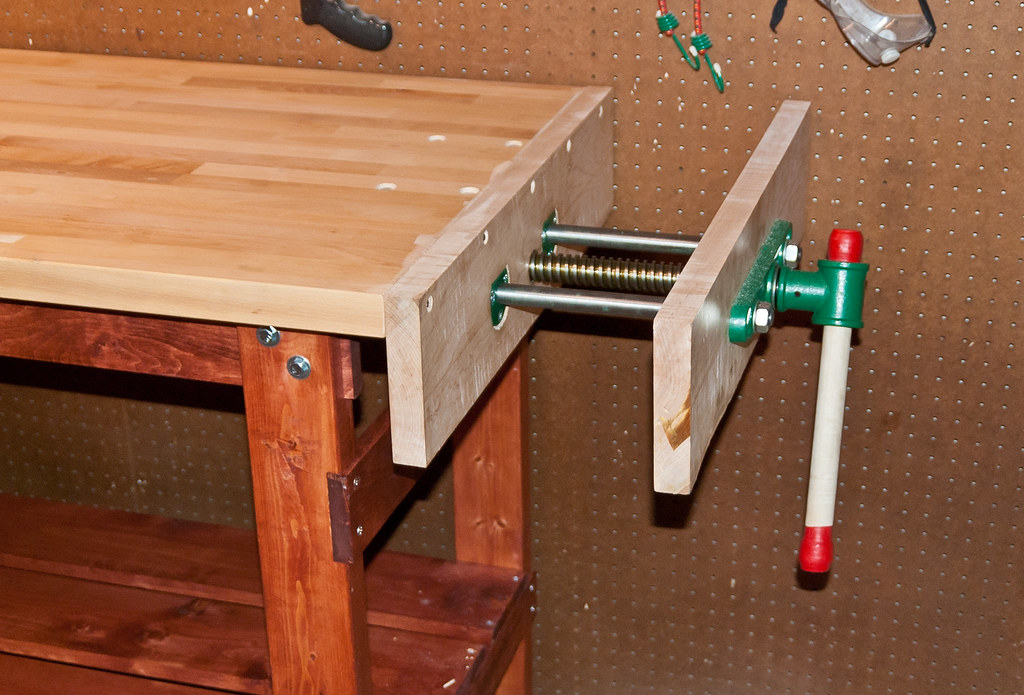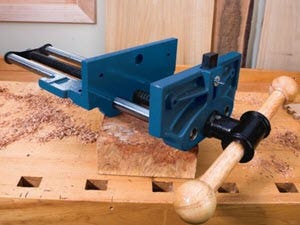
DIY Woodworking Vise
- Welding a Nut to a Base. I want to use a M16 threaded rod for the linear movement. ...
- Welding a T-Piece, a Washer and the Rod. I want to use a T-piece pipe to hold the threaded rod and a wooden rod later. ...
- First Test Run. Both parts are finished. Let's try if everything fits together. Looks very good. The difficult part is done.
- The Moveable Jaw. So what we need next is a moveable jaw for the vise. ...
- Mounting the Rod and the Support Pipes to the Jaw. I use two 5/8" copper pipes to support the rod and to keep the jaw from rotating. ...
- Drilling the Holes to the Workbench Jaw. This time I need three holes which go right through the workbench. ...
- Building the Flange. Remember the washer, which we welded to the T-piece? Now you'll see its purpose. ...
- Mounting the Washer With the Nut to the Workbench. We are almost finished here. ...
- Building the Handle. The last step is to build a handle. I use a 2cm wooden rod made of beech. ...
- Done. Well that's it. Now I have my own workbench vise. ...
- Test Run. Ok now let's get to business. I did some minor projects with the vise. ...
How to build a bowling ball vise?
“Fill the opened cavity almost to the top with lead shot to add weight, then seal the shot to the top of the hole with automotive Bondo® filler.” “Make a round cover for the flat top of the ball using metal, wood or Formica®. Mount your vise on top of this. Mine is a machinist’s vise using its mounting system.” “Make a base and you’re almost done.
How to make a wood vise?
Make a Bench Vise for Woodworking
- What You Need. About 16 linear feet of one by six hardwood (actual measurements ¾” x 5½”). ...
- Front Jaw. Cut two 32” long pieces from the one by six board. ...
- Rear Jaw. The rear jaw is L-shaped. ...
- Drill Holes for the Hex Bolts. Drill two ½” holes through the front jaw 3” from the short edge and 2 ¼” from the top edge. ...
- Make Handles. ...
- Use Your Bench Vise. ...
How to mount a woodworking vice?
Mounting a Wood Vise
- Select which Side. Choose which side of your workbench you will mount your work vise. ...
- Position the Wood Vice. Place the Wood Vice where you want it before bolting. ...
- Measuring. Mark out the holes where it requires bolting. ...
- Drilling. Then, drill the holes to allow the bolts to pass through your workbench. ...
- Bolting. ...
- Installing. ...
How to attach a vise to a drill press?
How to attach a Vise to a Drill Press
- Place the drill vice press atop the table of the drill press.
- Align the holes on the drill press vise with holes on the drill press table.
- Slide a 3/8 washer over 3/8 inch bolt and gently inch this through the hole aligned on the drill press table.
- Rotate the drill press vise to align another hole with the drill press table. ...

How thick should wood be for vise?
I would recommend at least one inch of hardwood onm the outside face of the chop. The inside face need not be as thick since it will not be compressed during tightening, so about 1/2" should do it.
How do you build a wood bench vise?
0:306:39DIY Woodworking Bench Vise - Quick and Easy Shop Project - YouTubeYouTubeStart of suggested clipEnd of suggested clipSo let's get. Started. Over at the table saw i cut a piece of 1 inch thick ash to 5 inches wide forMoreSo let's get. Started. Over at the table saw i cut a piece of 1 inch thick ash to 5 inches wide for the face of the vise.
How do you make a metal vise?
6:1810:06Make A Metal Drill Press Vise Without Welding - YouTubeYouTubeStart of suggested clipEnd of suggested clipI used those two metal strips. First i marked and grinded a groove on the rod with an angle. GrinderMoreI used those two metal strips. First i marked and grinded a groove on the rod with an angle. Grinder. Later on i made a different size u-shaped cut in the each metal strip.
What kind of wood is used for bench vices?
You can use plywood, a good grade, or solid wood, even pine, if that's what you have, to line the jaws of your vise. In this case I've chosen sapele, an african hardwood with perfect hardness and compression for this work. I've used it before and it's one of the best.
How do you make a homemade wooden vise?
0:167:17How to make a Workbench Vise ( DIY MOXON VISE ) - YouTubeYouTubeStart of suggested clipEnd of suggested clipOn one side of the jaw. I need to round out a dado slab. This will need to be equal to the thicknessMoreOn one side of the jaw. I need to round out a dado slab. This will need to be equal to the thickness of the plywood that will be used for the base the prow what I'm using is a bit thinner than 3/4.
How do I make a quick release vise?
0:3017:20Homemade Quick Release Vice - YouTubeYouTubeStart of suggested clipEnd of suggested clipAnd I've just cut into lengths and I've cut them at 500 mil. So my next job is to cut three holesMoreAnd I've just cut into lengths and I've cut them at 500 mil. So my next job is to cut three holes one either side for my guide rails where I'm using this tubing here off an old trampoline.
How do you make a big vise?
0:3719:16Making A Big 16” Vise from Tube and Plate. - YouTubeYouTubeStart of suggested clipEnd of suggested clipAnd a pretty good price range if you were to buy a used one I think this is going to be the mainMoreAnd a pretty good price range if you were to buy a used one I think this is going to be the main structure of the whole vise. It's a piece of 3 by 4 tubing quarter inch wall.
How do you make a vice clamp?
1:107:296 homemade clamps and workbench vises - YouTubeYouTubeStart of suggested clipEnd of suggested clipThese are just a couple of strips with two bolts. I put the work pieces between the strips. AndMoreThese are just a couple of strips with two bolts. I put the work pieces between the strips. And there are a lot of holes all along both strips.
How is a bench vise made?
Bench vises are commonly made in two distinct processes: casting and forging. Casting is the most common and cost effective manufacturing process. It involves pouring hot liquid metal into molds. Once poured into the mold the liquid steel is allowed to cool.
What material are vise jaws made of?
Metal vise jaws are usually made of aluminum or soft steel. They are sometimes heat treated, anodized, or coated with black oxide. Plastic vise jaws are usually made of polyurethane (PU), a broad category of polymers that resists abrasion and solvents to varying degrees.
How do you protect wood in a vise?
0:151:08How to Prevent a Workshop Vice from Damaging Wood - YouTubeYouTubeStart of suggested clipEnd of suggested clipJust put it in place crank. It down I matter how much pressure you put on this. You're going to haveMoreJust put it in place crank. It down I matter how much pressure you put on this. You're going to have those pads in place.
Do I need a woodworking vise?
The sturdy engineer's vise is essential for anyone who works with metal—which includes almost every woodworker, by the way, when it comes to sharpening, and dealing with all sorts of hardware and other components. Each vise has some specialized advantages, but you'll have to make the call.
How do I make a portable bench vise?
0:271:27How to make your bench vice portable - YouTubeYouTubeStart of suggested clipEnd of suggested clipNow that you've drilled the holes you're going to turn the board over and Mark out the top of theMoreNow that you've drilled the holes you're going to turn the board over and Mark out the top of the bolts. So now you want to chisel out like this so the ball is sits under the surface.
How do you make a Moxon Vise?
0:0815:06$40 Moxon Vise - Easy to build in an afternoon! - YouTubeYouTubeStart of suggested clipEnd of suggested clipThis kit comes with everything that you need to build a quality Moxon vise it also comes with a setMoreThis kit comes with everything that you need to build a quality Moxon vise it also comes with a set of instructions.
How do you make a drill press vise?
3:539:44Homemade Drill Press Vise - YouTubeYouTubeStart of suggested clipEnd of suggested clipI cut the pins which are just wooden dowels down to their final size and tested the fit of theMoreI cut the pins which are just wooden dowels down to their final size and tested the fit of the backing on the base. After that I started laying out the rest of the components. I decided on pre
How do you make a vise clamp?
1:107:296 homemade clamps and workbench vises - YouTubeYouTubeStart of suggested clipEnd of suggested clipThese are just a couple of strips with two bolts. I put the work pieces between the strips. AndMoreThese are just a couple of strips with two bolts. I put the work pieces between the strips. And there are a lot of holes all along both strips.
How to fix a rod on a nut?
To fix the rod, we added a small hole through the T-piece and the rod and insert a small bolt. Now you can turn the rod by turning the T-piece.
Is maple wood good for a work bench?
very nice. The only problem I have is you should have used hardwoods for maximum durability. Some maple would not have been too costly. Over time you will find these things matter in a work bench. It really gets beat up and a soft wood will not endure as much abuse.
How to cut a mortise for a nut?
Use a chisel to chop out the mortise for the nut. Test fit multiple times until nut sits flush with the top of the chop.
How to increase gripping power of chops?
Adding cork to the clamping side of both chops will increase the gripping power and protect the piece being clamped. I used adhesive backed drawer liner. Just line up your face on the unrolled cork, cut, stick the the jaw face, and trim to fit. Make sure the wood is clean and dust free.
Can you clamp a vise to a bench?
You be able to clamp the vise to your bench, you'll want to add a small board a little longer than your vise to act as a clamping surface. I used a piece of southern yellow pine attached with three brass screws to the back side of the rear chop. I used a hand drill to pre-drill all of the holes before attaching.
